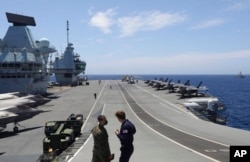Britain’s readiness and ability to fight a major conflict is under the spotlight after senior military officials at home and abroad questioned cuts to the country’s armed forces at a time of heightened global threats.
In a rare intervention, a senior United States official urged its ally Britain to reassess the size of its armed forces. The remarks, by U.S. Navy Secretary Carlos Del Toro, echo concerns of senior military commanders in Britain.
“I think it is important for the United Kingdom to reassess where they are today given the threats that exist today,” Del Toro told an audience at London’s Royal United Services Institute January 25, adding that Britain had to make a “decision around whether the army needs to be strengthened.”
He also spoke of his “tremendous respect” for the UK’s armed forces and praised the joint efforts between Britain and the U.S. in Operation Prosperity Guardian, a multinational force targeting Houthi rebels in Yemen to safeguard commercial shipping in the Red Sea.
Britain’s government defended its spending on the armed forces. A spokesperson for the British Prime Minister Rishi Sunak said in a statement following Del Toro’s remarks: “The UK is the second biggest defense spender in NATO and the largest in Europe. The Navy, Army and Royal Air Force are all playing an active global role, operating across every ocean and continent. Our military strength is also why we are the U.S.’s partner of choice in taking action to defend against the Houthi attacks in the Red Sea.”
Meanwhile, some 20,000 British troops are set to take part in Exercise Steadfast Defender 2024 — NATO’s biggest drills since the Cold War. British Defense Secretary Grant Shapps highlighted Britain’s contribution in a speech last month.
“It will see our military joining forces with counterparts from 30 NATO countries — plus Sweden — providing reassurance against the Putin menace. Our carrier strike group will be out in full force, with our magnificent flagship HMS Queen Elizabeth leading the way, and flying from her decks will be the fifth generation F-35 Lightning jets,” Shapps said.
Behind that veneer, however, critics argue Britain’s armed forces are underfunded, underequipped and facing a recruitment crisis.
General Patrick Sanders, the outgoing head of the British army, warned recently that more needs to be done to equip and modernize the country’s armed forces in the face of the threat from Russia. Britain has about 73,000 soldiers — half the size it was 30 years ago. Sanders said Britain may need to train a “civilian army” in the event of a major war.
“Although there’s a lot of rhetoric from British defense ministers and senior officials that numbers aren’t everything, numbers are pretty important,” said Brigadier (Retired) Ben Barry, senior fellow for land warfare at the International Institute for Strategic Studies in London.
“For example, a tank or a frigate or an F-35 can’t be in two places at once. It’s also fair to say that the British armed forces have a broad range of capabilities, which I think the U.S. welcomes, but many of those are themselves very small. For example, the British army can only produce a single division. The French army can produce two, the German army can produce three,” Barry told VOA.
The British army, navy and air force have all missed recruitment targets, according to government figures, with navy recruitment down by 22 percent in the 12 months to March 2023, compared with the previous year.
Two British naval frigates, the HMS Westminster and the HMS Argyll, are set to be decommissioned this year owing to a lack of crew able to operate them, reducing the total to nine, according to a report by London’s The Daily Telegraph.
The government did not comment on the newspaper report but highlighted that it has ordered eight new frigates — although these won’t be in service until at least the end of the decade.
Meanwhile, there are shortages of equipment across the armed forces, according to Barry, of the International Institute for Strategic Studies.
“All three armed forces don’t have sufficient stockpiles of ammunition and spare parts to conduct a sustained battle for the length of time that NATO envisages, and that NATO requires them to do,” Barry said.
“What we’ve seen over the last couple of years is the relative hollowing out of Europe’s armed forces, very publicly displayed with the well-reported difficulties of supplying enough equipment — weapons and ammunition — for Ukraine,” he said.
The British government has pledged to spend 2.5 percent of GDP on defense by 2030 and said it was committed to spending more “when conditions allow.”
Barry said the British military was still effective.
“One key ingredient is actually that they are willing to fight. And I think it’s fair to say the British armed forces still retain an ethos of combat in their DNA. And the British public, politicians and the media all see the use of force against the country’s enemies, in extremis [in highly difficult circumstances], as what the armed forces are for. That’s not true in all European or Western countries,” he told VOA.



